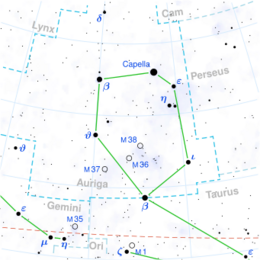Astronomy:Psi7 Aurigae
| Observation data Equinox J2000.0]] (ICRS) | |
|---|---|
| Constellation | Auriga |
| Right ascension | 06h 50m 45.94330s[1] |
| Declination | +41° 46′ 52.4267″[1] |
| Apparent magnitude (V) | 5.02[2] |
| Characteristics | |
| Spectral type | K3 III[3] |
| U−B color index | +1.35[2] |
| B−V color index | +1.27[2] |
| R−I color index | 0.46 |
| Astrometry | |
| Radial velocity (Rv) | +59.53 ± 0.25[4] km/s |
| Proper motion (μ) | RA: –25.660[5] mas/yr Dec.: –138.163[5] mas/yr |
| Parallax (π) | 9.8872 ± 0.1499[5] mas |
| Distance | 330 ± 5 ly (101 ± 2 pc) |
| Absolute magnitude (MV) | −0.33[6] |
| Details | |
| Radius | 24[7] R☉ |
| Luminosity | 217[6] L☉ |
| Surface gravity (log g) | 2.35[8] cgs |
| Temperature | 4,300[8] K |
| Metallicity [Fe/H] | 0.00[8] dex |
| Rotational velocity (v sin i) | 10[9] km/s |
| Other designations | |
| Database references | |
| SIMBAD | data |
Psi7 Aurigae, Latinized from ψ7 Aurigae, is a star in the northern constellation of Auriga. It is a dim, naked eye star with an apparent visual magnitude of 5.02. Based upon Gaia Data Release 2 parallax values, it is approximately 330 light-years (100 parsecs) from Earth.
ψ7 Aurigae is a giant star with a stellar classification of K3 III.[3] The measured angular diameter of this star, after correction for limb darkening, is 1.96 ± 0.04 mas.[11] At its estimated distance,[1] this yields a physical size of about 24 times the radius of the Sun.[7] The outer envelope has an effective temperature of 4,300,[8] giving it an orange colour and a classification as a K-type star.[12] Although cooler than the sun, its larger size means that it is more luminous, emitting in total 217 times as much electromagnetic radiation.
It was also known to be part of a much bigger constellation named Telescopium Herschelii before it was unrecognized by the International Astronomical Union (IAU).
See also
References
- ↑ 1.0 1.1 1.2 van Leeuwen, Floor (November 2007), "Validation of the new Hipparcos reduction", Astronomy and Astrophysics 474 (2): 653–664, doi:10.1051/0004-6361:20078357, Bibcode: 2007A&A...474..653V. Note: see VizieR catalogue I/311.
- ↑ 2.0 2.1 2.2 Johnson, H. L. et al. (1966), "UBVRIJKL photometry of the bright stars", Communications of the Lunar and Planetary Laboratory 4 (99): 99, Bibcode: 1966CoLPL...4...99J
- ↑ 3.0 3.1 Roman, Nancy G. (July 1952), "The Spectra of the Bright Stars of Types F5-K5", Astrophysical Journal 116: 122, doi:10.1086/145598, Bibcode: 1952ApJ...116..122R.
- ↑ Famaey, B. et al. (January 2005), "Local kinematics of K and M giants from CORAVEL/Hipparcos/Tycho-2 data. Revisiting the concept of superclusters", Astronomy and Astrophysics 430 (1): 165–186, doi:10.1051/0004-6361:20041272, Bibcode: 2005A&A...430..165F.
- ↑ 5.0 5.1 5.2 Brown, A. G. A. (August 2018). "Gaia Data Release 2: Summary of the contents and survey properties". Astronomy & Astrophysics 616: A1. doi:10.1051/0004-6361/201833051. Bibcode: 2018A&A...616A...1G. Gaia DR2 record for this source at VizieR.
- ↑ 6.0 6.1 Anderson, E.; Francis, Ch. (2012), "XHIP: An extended hipparcos compilation", Astronomy Letters 38 (5): 331, doi:10.1134/S1063773712050015, Bibcode: 2012AstL...38..331A.
- ↑ 7.0 7.1 Lang, Kenneth R. (2006), Astrophysical formulae, Astronomy and astrophysics library, 1 (3rd ed.), Birkhäuser, ISBN 3-540-29692-1, https://books.google.com/books?id=OvTjLcQ4MCQC&pg=PA41. The radius (R*) is given by:
- [math]\displaystyle{ \begin{align} 2\cdot R_* & = \frac{(116\cdot 1.96\cdot 10^{-3})\ \text{AU}}{0.0046491\ \text{AU}/R_{\bigodot}} \\ & \approx 48.9\cdot R_{\bigodot} \end{align} }[/math]
- ↑ 8.0 8.1 8.2 8.3 McWilliam, Andrew (December 1990), "High-resolution spectroscopic survey of 671 GK giants. I - Stellar atmosphere parameters and abundances", Astrophysical Journal Supplement Series 74: 1075–1128, doi:10.1086/191527, Bibcode: 1990ApJS...74.1075M.
- ↑ Bernacca, P. L.; Perinotto, M. (1970), "A catalogue of stellar rotational velocities", Contributi Osservatorio Astronomico di Padova in Asiago 239 (1): 1, Bibcode: 1970CoAsi.239....1B.
- ↑ "* 58 Aur". SIMBAD. Centre de données astronomiques de Strasbourg. http://simbad.u-strasbg.fr/simbad/sim-basic?Ident=%2A+58+Aur.
- ↑ Richichi, A.; Percheron, I.; Khristoforova, M. (February 2005), "CHARM2: An updated Catalog of High Angular Resolution Measurements", Astronomy and Astrophysics 431 (2): 773–777, doi:10.1051/0004-6361:20042039, Bibcode: 2005A&A...431..773R
- ↑ "The Colour of Stars", Australia Telescope, Outreach and Education (Commonwealth Scientific and Industrial Research Organisation), December 21, 2004, http://outreach.atnf.csiro.au/education/senior/astrophysics/photometry_colour.html, retrieved 2012-01-16.
External links
 |



